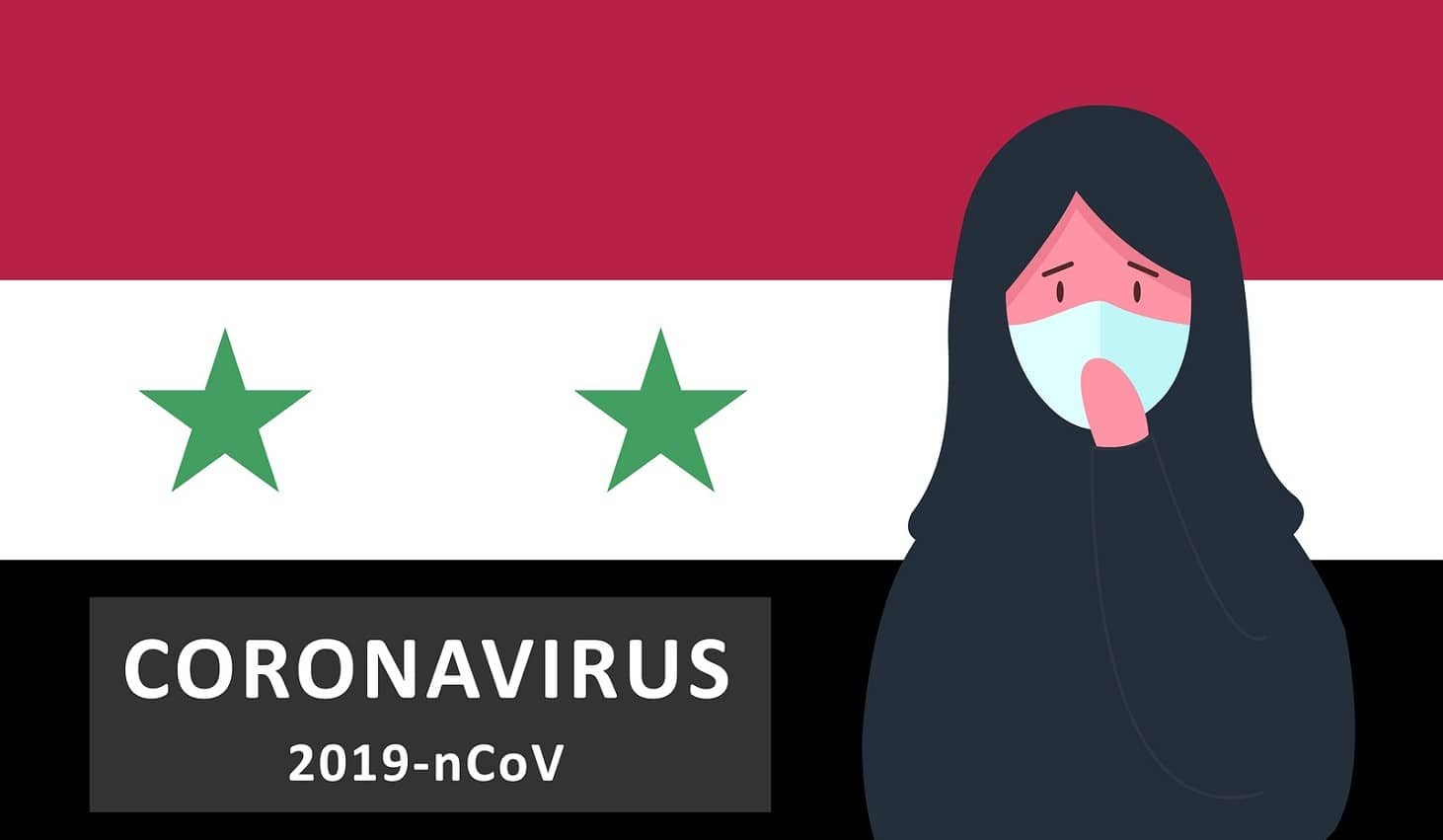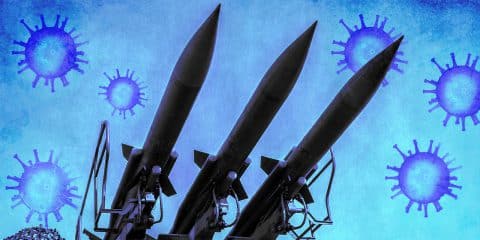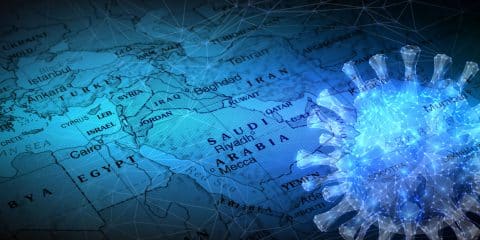The ‘ghost caliphate’ – Sunni Arab insurgency – is likely to persist in the remote, poor and sparsely governed areas of Syria and Iraq.
The coronavirus is generally held to represent a common threat to all nations and communities. It does not differentiate according to religion, ethnicity or national origin. The pandemic has even produced examples of enemies working together against the new invisible foe. Medical personnel from Hamas-controlled Gaza, for example, have traveled to Israeli hospitals to learn techniques for treating those infected.
But the virus, and more specifically the general focus on it, also offer an opportunity to any organization seeking to exploit the short-term distraction of its enemies.
Islamic State, commonly known as ISIS, lacks administrative control of any territory. But across a broad swath of Iraq and Syria, ISIS retains networks of support, and lines of communication and supply. Somewhere between 20,000 and 30,000 members of the group remain active in this area. There is no shortage of either money or weaponry.
From Syria’s Badia desert in the west, eastward to the Euphrates River valley and Deir al-Zor province, and then deep into Sunni-majority central Iraq, the vanquished ISIS caliphate retains a kind of half-life. Beneath the nominal authority of three administrations – the Assad regime, the Kurdish-led Syrian Democratic Council and the government of Iraq, the structures and networks of ISIS are alive.
And with all three of these administrations preoccupied with the current pandemic, Islamic State is raising its head. A sharp uptick in ISIS activity has taken place across this space over the last two weeks.
Further west, on April 9, ISIS gunmen attacked and seized the town of al-Sukhna in the desert of central Homs province. Russian aircraft were scrambled in response, launching a series of air raids against the positions of the jihadis. Extended clashes followed between the ISIS men and Assad regime forces. The latter were accompanied by fighters from a pro-regime Palestinian militia called the Al-Quds Brigade. This unit, founded in Aleppo in 2013, is associated with the PFLP-GC. The death count after the ISIS fighters disappeared back into the desert was 18 on the regime/al-Quds side, and 11 ISIS men, according to the Syrian Observatory for Human Rights.
In eastern Deir al-Zor province, ISIS fighters killed two members of the National Defense Forces, an Iran-established regime auxiliary force, on April 7. In the same period in this area, the Sunni jihadis on April 6 executed a woman they claimed was working with the regime, and on April 7 detonated a land mine in the Shola area in southern Deir al-Zor, killing four members of the Al-Quds Brigade. ISIS also attacked regime positions in the towns of al-Jala, al-Siyal and al-Abbas in the same area on April 6. According to the Observatory, the latest attacks bring the death toll among regime and allied forces west of the Euphrates at the hands of ISIS from the period March 24 to the present day to 377.
The Kurdish/US-controlled area east of the Euphrates has also been hit by the uptick in ISIS activity. On April 3, an SDF unit killed an ISIS would-be suicide bomber in the town of Manbij, as he prepared to carry out his attack.
The situation in the mainly Sunni Arab Middle Euphrates River Valley is tense. There are unresolved issues of authority and governance between the Sunni Arab tribal population in the area and the SDF. ISIS seeks to gain from this situation, and attacks have been on the increase since February. The problem of sleeper cells remains acute.
A base of support undoubtedly exists for the Sunni jihadis in this area. They resent the rule of the “PKK,” as they refer to the Kurdish-led Syrian Democratic Council, which governs the area. This issue is compounded by the uncertainty in the area. President Donald Trump’s announcement in October 2019 of the imminent withdrawal of remaining US forces from northeast Syria has reduced the willingness of some elements in the population to cooperate with the SDF, since its hold on the area is seen as only temporary.
A central concern for both the SDF and its US partners is the roughly 11-12,000 ISIS prisoners held in a number of facilities east of the Euphrates. Already, ISIS prisoners have staged one attempted breakout. In late March, 4 members of the organization escaped from the Ghweran prison, near Hasakah city. All were recaptured.
The public health situation in the SDF-controlled area is fragile. Water supplies are subject to intermittent interruptions, because of Turkish control of the Allouk water station, since Operation Olive Branch in late 2019. There is also an acute shortage of medical equipment, including testing kits and ventilators.
There is concern that if COVID-19 strikes in the area, facilities holding ISIS prisoners could become unmanageable.
The Syrian regime permits little aid material to reach the SDF-controlled areas. The US-led coalition has as a result begun in recent days to provide some materials to help preserve hygiene in the facilities holding ISIS prisoners.
Iraq, too, has witnessed renewed ISIS violence in recent days. A report on the Kurdish Rudaw website on Tuesday noted the death of an Iraqi federal police officer at a checkpoint in Hawija in western Kirkuk on Sunday, April 12. Hawija is a focal point of support and activity for ISIS. The report noted that this was the third killing of security forces personnel by the organization since the beginning of the month. Two Kurdish Peshmerga fighters were killed in an attack on Tuesday, April 7. An additional attack near al-Sadeq military airport on Thursday, April 9, killed two members of the Shia Popular Mobilization Units.
The Iraqi security forces are currently focused on the pandemic. The attacks come also in the wake of US redeployment of forces within Iraq in recent weeks, and the continued paralysis of the political system.
So the increase in ISIS activity is taking place across a broad but contiguous majority-Sunni Arab area of territory. The pattern of events confirms the continued existence of ISIS’s networks of supply and support, through which the movement’s members can safely pass. This is the “ghost caliphate” in the territory that the movement once administered. Now it exists in clandestine form, striking at the successor authorities when opportunity presents.
The ongoing, slow-burning ISIS insurgency in this area is proof that the “victories” in the wars in Syria and Iraq have resolved little.
Neither the Assad regime’s crushing of the Sunni Arab uprising against it, nor the US-led coalition’s destruction of the ISIS caliphate has settled the underlying issue that led to the emergence of both. This is the fact that both Baghdad and Damascus are dominated by non-Sunni ruling authorities with little interest in, or ability to integrate, the large Sunni Arab populations living under their rule.
For as long as this remains the case, Sunni Arab insurgency, latent or open, is likely to persist in the remote, poor and sparsely governed areas of both countries.
The coronavirus offers a window for ISIS to increase the tempo of its activities. But with or without the pandemic, the ‘ghost caliphate’ is here to stay.
Published in The Jerusalem Post, 17.04.2020
JISS Policy Papers are published through the generosity of the Greg Rosshandler Family.
photo: Bigstock









 - בניית אתרים
- בניית אתרים